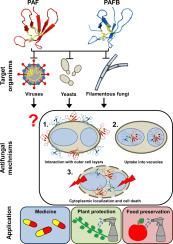当前位置:
X-MOL 学术
›
BBA Biomembr.
›
论文详情
Our official English website, www.x-mol.net, welcomes your feedback! (Note: you will need to create a separate account there.)
Two small, cysteine-rich and cationic antifungal proteins from Penicillium chrysogenum: A comparative study of PAF and PAFB.
Biochimica et Biophysica Acta (BBA) - Biomembranes ( IF 3.4 ) Pub Date : 2020-03-03 , DOI: 10.1016/j.bbamem.2020.183246 A Huber 1 , L Galgóczy 2 , G Váradi 3 , J Holzknecht 1 , A Kakar 1 , N Malanovic 4 , R Leber 4 , J Koch 5 , M A Keller 5 , G Batta 6 , G K Tóth 7 , F Marx 1
Biochimica et Biophysica Acta (BBA) - Biomembranes ( IF 3.4 ) Pub Date : 2020-03-03 , DOI: 10.1016/j.bbamem.2020.183246 A Huber 1 , L Galgóczy 2 , G Váradi 3 , J Holzknecht 1 , A Kakar 1 , N Malanovic 4 , R Leber 4 , J Koch 5 , M A Keller 5 , G Batta 6 , G K Tóth 7 , F Marx 1
Affiliation

|
The filamentous fungus Penicillium chrysogenum Q176 secretes the antimicrobial proteins (AMPs) PAF and PAFB, which share a compact disulfide-bond mediated, β-fold structure rendering them highly stable. These two AMPs effectively inhibit the growth of human pathogenic fungi in micromolar concentrations and exhibit antiviral potential without causing cytotoxic effects on mammalian cells in vitro and in vivo. The antifungal mechanism of action of both AMPs is closely linked to - but not solely dependent on - the lipid composition of the fungal cell membrane and requires a strictly regulated protein uptake into the cell, indicating that PAF and PAFB are not canonical membrane active proteins. Variations in their antifungal spectrum and their killing dynamics point towards a divergent mode of action related to their physicochemical properties and surface charge distribution. In this review, we relate characteristic features of PAF and PAFB to the current knowledge about other AMPs of different sources. In addition, we present original data that have never been published before to substantiate our assumptions and provide evidences that help to explain and understand better the mechanistic function of PAF and PAFB. Finally, we underline the promising potential of PAF and PAFB as future antifungal therapeutics.
中文翻译:

来自产黄青霉的两种富含半胱氨酸的小阳离子抗真菌蛋白:PAF 和 PAFB 的比较研究。
丝状真菌 Penicillium chrysogenum Q176 分泌抗菌蛋白 (AMP) PAF 和 PAFB,它们具有紧凑的二硫键介导的 β 折叠结构,使其高度稳定。这两种 AMP 在微摩尔浓度下有效抑制人类病原真菌的生长,并表现出抗病毒潜力,而不会在体外和体内对哺乳动物细胞产生细胞毒性作用。两种 AMP 的抗真菌作用机制与真菌细胞膜的脂质成分密切相关,但不仅仅依赖于其,并且需要严格调节蛋白质摄取到细胞中,这表明 PAF 和 PAFB 不是典型的膜活性蛋白。它们的抗真菌谱和杀灭动力学的变化指向与其物理化学性质和表面电荷分布相关的不同作用模式。在这篇综述中,我们将 PAF 和 PAFB 的特征与当前关于不同来源的其他 AMP 的知识联系起来。此外,我们提供了以前从未发表过的原始数据来证实我们的假设,并提供有助于更好地解释和理解 PAF 和 PAFB 的机械功能的证据。最后,我们强调了 PAF 和 PAFB 作为未来抗真菌药物的巨大潜力。我们提供以前从未发表过的原始数据来证实我们的假设,并提供有助于更好地解释和理解 PAF 和 PAFB 的机械功能的证据。最后,我们强调了 PAF 和 PAFB 作为未来抗真菌治疗药物的巨大潜力。我们提供以前从未发表过的原始数据来证实我们的假设,并提供有助于更好地解释和理解 PAF 和 PAFB 的机械功能的证据。最后,我们强调了 PAF 和 PAFB 作为未来抗真菌治疗药物的巨大潜力。
更新日期:2020-03-03
中文翻译:

来自产黄青霉的两种富含半胱氨酸的小阳离子抗真菌蛋白:PAF 和 PAFB 的比较研究。
丝状真菌 Penicillium chrysogenum Q176 分泌抗菌蛋白 (AMP) PAF 和 PAFB,它们具有紧凑的二硫键介导的 β 折叠结构,使其高度稳定。这两种 AMP 在微摩尔浓度下有效抑制人类病原真菌的生长,并表现出抗病毒潜力,而不会在体外和体内对哺乳动物细胞产生细胞毒性作用。两种 AMP 的抗真菌作用机制与真菌细胞膜的脂质成分密切相关,但不仅仅依赖于其,并且需要严格调节蛋白质摄取到细胞中,这表明 PAF 和 PAFB 不是典型的膜活性蛋白。它们的抗真菌谱和杀灭动力学的变化指向与其物理化学性质和表面电荷分布相关的不同作用模式。在这篇综述中,我们将 PAF 和 PAFB 的特征与当前关于不同来源的其他 AMP 的知识联系起来。此外,我们提供了以前从未发表过的原始数据来证实我们的假设,并提供有助于更好地解释和理解 PAF 和 PAFB 的机械功能的证据。最后,我们强调了 PAF 和 PAFB 作为未来抗真菌药物的巨大潜力。我们提供以前从未发表过的原始数据来证实我们的假设,并提供有助于更好地解释和理解 PAF 和 PAFB 的机械功能的证据。最后,我们强调了 PAF 和 PAFB 作为未来抗真菌治疗药物的巨大潜力。我们提供以前从未发表过的原始数据来证实我们的假设,并提供有助于更好地解释和理解 PAF 和 PAFB 的机械功能的证据。最后,我们强调了 PAF 和 PAFB 作为未来抗真菌治疗药物的巨大潜力。


























 京公网安备 11010802027423号
京公网安备 11010802027423号